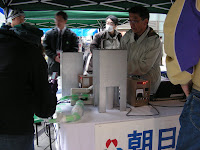Test Your Food: The Results Are In...

...and the good news is that my leek onions had no detectable levels of radiation. I was quite happy to hear that of course. I hadn't expected any high levels as my field is far from the Fukushima Daiichi Nuclear Plant. But, it is nice to have done the testing. I also brought a sample of my soil and it had 140 Bq/kg which is very low.
What does all this mean? In a new article published over at Japan Focus, I try to make sense of the large amount of data we now have, one year after the earthquake and tsunami wrecked havoc on March 11, 2011. The Japanese government publishes the results of the testing of food samples, and so far over 120,000 samples have been analyzed. For Fukushima prefecture, over 20,000 food samples have been tested and the results published. So, we have a pretty good picture of the situation.
Japan Focus: Food Safety in Japan: One Year after the Nuclear Disaster
 For example, for the 120,000 food products have been tested, the total number of cases that exceeded the limit was 1,162 or just below 1%. Thus, looking at these numbers we realize that the food contamination situation could have been a lot worse!
For example, for the 120,000 food products have been tested, the total number of cases that exceeded the limit was 1,162 or just below 1%. Thus, looking at these numbers we realize that the food contamination situation could have been a lot worse!Out of 43 prefectures in Japan, contaminated food samples above the 500 Bq/kg limit have been found in 14 prefectures. For the rest of the country, or 29 prefectures, the situation is even better, with no high levels at all. New, stricter limits will be introduced from April 1, 2012 which is also good news for consumers.
(I did get some comments on that article, pointing out that some people believe there is "no safe limit" and that children in particular should not be exposed to radiation, "so one who cares about safety by definition needs to provide critical assessment of government standards." as one commentator pointed out.)
I do think it is worth noting that testing is going on in other countries, and their results are also giving Japanese foods the thumbs up. For example, the United States has published data:
"As of March 14th, FDA import investigators had performed 31,007 field examinations for radionuclide contamination. FDA had tested 1257 samples, 194 which were seafood or seafood products. 1256 samples had no Iodine-131, Cesium-134, Cesium-137, or other gamma-ray emitting radionuclides of concern. 1 sample was found to contain detectable levels of Cesium, but was below the established Derived Intervention Level (DIL) and posed no public health concern."
FDA: What has FDA’s screening and testing shown so far?
 It was a fun day in Nippori at the usual food market, with lots of noisy taiko drumming by a team of kids on the stage, and I was glad to meet fellow food blogger Joan of Popcorn Homestead fame, who brought her husband along - but she had forgotten her soil sample! She will have more opportunities, as the same team will bring their sophisticated detector to Nippori, east exit of the JR station, on the following dates at a veggie shop called Saisai-ya (菜菜や): March 31 and April 7, 14, 21, 28.
It was a fun day in Nippori at the usual food market, with lots of noisy taiko drumming by a team of kids on the stage, and I was glad to meet fellow food blogger Joan of Popcorn Homestead fame, who brought her husband along - but she had forgotten her soil sample! She will have more opportunities, as the same team will bring their sophisticated detector to Nippori, east exit of the JR station, on the following dates at a veggie shop called Saisai-ya (菜菜や): March 31 and April 7, 14, 21, 28.

Comments